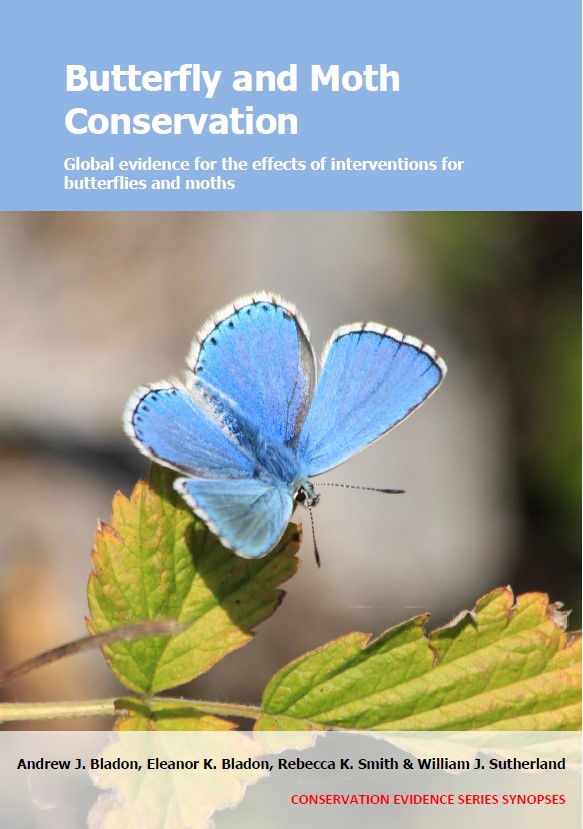Actions to conserve biodiversity
We have summarised evidence from the scientific literature about the effects of actions to conserve wildlife and ecosystems.
Review the evidence from the studies
Not sure what Actions are? Read a brief description.
Search for evidence
e.g. "frogs chytrid"
152 Actions found
Refine
Hide
152 Actions found
Download Actions
| 0 selected |
|
Order results by:
| Action | Effectiveness | Studies | Category | |
|---|---|---|---|---|
|
Increase crop diversity across a farm or farmed landscape Action Link |
Awaiting assessment | 2 |
|
|
|
Undersow spring cereals, with clover for example Action Link |
Awaiting assessment | 2 |
|
|
|
Manage woodland edges for maximum habitat heterogeneity Action Link |
Awaiting assessment | 2 |
|
|
|
Raise cutting height on grasslands Action Link |
Awaiting assessment | 2 |
|
|
|
Use motor bar mowers rather than rotary mowers Action Link |
Awaiting assessment | 2 |
|
|
|
Retain connectivity between habitat patches Action Link |
Awaiting assessment | 3 |
|
|
|
Harvest groups of trees or use thinning instead of clearcutting Action Link |
Awaiting assessment | 3 |
|
|
|
Use shelterwood harvesting instead of clearcutting Action Link |
Awaiting assessment | 3 |
|
|
|
Produce coffee in shaded plantations Action Link |
Evidence not assessed | 3 |
|
|
|
Change mowing regime on grassland Action Link |
Awaiting assessment | 3 |
|
|
|
Manage heathland by cutting Action Link |
Evidence not assessed | 3 |
|
|
|
Restore or create heathland/shrubland Action Link |
Evidence not assessed | 3 |
|
|
|
Manage wetlands or ponds by grazing or cutting to prevent succession Action Link |
Awaiting assessment | 3 |
|
|
|
Restore or create wetlands and floodplains Action Link |
Awaiting assessment | 3 |
|
|
|
Use mixed stocking Action Link |
Awaiting assessment | 3 |
|
|
|
Maintain upland heath/moorland Action Link |
Awaiting assessment | 3 |
|
|
|
Practise ‘wildlife gardening’ Action Link |
Evidence not assessed | 4 |
|
|
|
Restore or create new habitats after mining and quarrying Action Link |
Awaiting assessment | 4 |
|
|
|
Use selective or reduced impact logging instead of conventional logging Action Link |
Awaiting assessment | 4 |
|
|
|
Encourage natural regeneration in former plantations or logged forest Action Link |
Evidence not assessed | 4 |
|
|
|
Translocate to establish populations outside of known range Action Link |
Evidence not assessed | 4 |
|
|
|
Leave uncropped, cultivated margins or plots Action Link |
Evidence not assessed | 4 |
|
|
|
Create beetle banks Action Link |
Awaiting assessment | 4 |
|
|
|
Maintain or create bare ground Action Link |
Evidence not assessed | 4 |
|
|
|
Change type of livestock grazing Action Link |
Awaiting assessment | 4 |
|
Download Actions
| 0 selected |
|

Butterfly and Moth Conservation - Published 2023
Butterfly and Moth Synopsis
Watch this search
If you are familiar with RSS feeds, please click the button below to retrieve the feed URL:
RSS feed for this searchIf you are unfamiliar with RSS feeds, we would suggest reading this BBC article.
Unfortunately, due to the number of feeds we have available, we cannot provide e-mail updates. However, you could use tools such as Feed My Inbox to do this for you.
What are 'Individual studies' and 'Actions'?
Individual studies
An individual study is a summary of a specific scientific study, usually taken from a scientific journal, but also from other resources such as reports. It tells you the background context, the action(s) taken and their consequences.
If you want more detail please look at the original reference.
Actions
Each action page focuses on a particular action you could take to benefit wildlife or ecosystems.
It contains brief (150-200 word) descriptions of relevant studies (context, action(s) taken and their consequences) and one or more key messages.
Key messages show the extent and main conclusions of the available evidence. Using links within key messages, you can look at the paragraphs describing each study to get more detail. Each paragraph allows you to assess the quality of the evidence and how relevant it is to your situation.
Where we found no evidence, we have been unable to assess whether or not an intervention is effective or has any harmful impacts.





)_2023.JPG)














